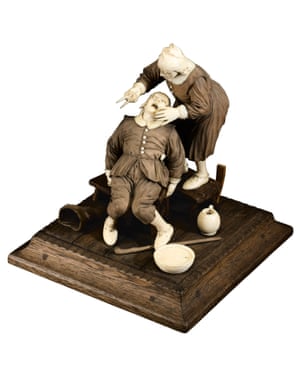Dentophobia
She’s
always had
a
fear of dentists
so
today I take her
over
for her root canal
supporting
her the best
I
can by sitting in the waiting room
fiddling
with my iPhone
and
trying to write
but
too distracted by the dreadful drilling
and
grinding noises emanating
from
the torture devices
in
the next room.
Fortunately
the oral surgeon
is a
woman so now I’m not pressured
to
storm back there and beat the crap
out
of the guy
for
hurting my girl.

[17th century statue]
Saint Apollonia, Patron Saint of Dentistry -- Karen Rexrode
In the 290s Eusebios of Caesarea claimed that patriarch Babylas of Antioch had refused to let Roman emperor Marcus Julius Philippus Augustus, “Philip the Arab” enter his church during the Easter vigil; later accounts claimed that Babylas insisted that he must do penance for his role in the 244 death of his young predecessor Marcus Antonius Gordianus Pius Augustus (Gordian III). (Gordianus had been 13 when he became emperor in 238, and he died under mysterious circumstances 6 years later during a war against the Persians.) As a result of Philippus’ confession, some early Christians regarded him as the 1st Christian emperor, though he continued to follow the state religion in his decrees, coinage, and other public acts, and no non-Christian writers alluded to his apostasy. In fact, he may not even have been tolerant toward them. The emperor was back in Roma by August 247, when he began planning his celebration of the Ludi Saeculares, 3-day festivities and sacrifices that marked the transition of one saeculum to the next. (A saeculum was regarded as the longest possible length of human life, either 100 or 110 years); the 248 event coincided with the 1,000th anniversary of the foundation of Roma. In the Colosseum, in what had been originally prepared for Gordianas’ planned Roman triumph over the Persians, more than 1,000 gladiators and hundreds of exotic animals were killed. The patriotic fervor spread throughout the empire. In 249 an Alexandrian mob launched a pogrom against those who refused to worship the official gods. Hundreds were assaulted, stoned, burned, or cut down, including an aged deaconess, Apollonia, who was beaten and her teeth were violently pulled out or shattered. Then the mob threatened to throw her into a fire, but she leaped into the flames of her only volition. Back in Roma, Phillipus offered to abdicate due to his inability to govern, but the future emperor Caesar Gaius Messius Quintus Trajanus Decius Augustus persuaded the Senatus to maintain its support. As a result Phillipus gave Decius a special command to quell a rebellious legion and halt a barbarian invasion, but his troops proclaimed him emperor and he marched on the capital. Decius defeated Phillipus near Verona in Seprtember 249. In 250 Decius ordered everyone to sacrifice to the Roman gods (though he exempted the Jews), thus initiating a new pogrom that lasted until the next year.
ReplyDelete